 Éstouffade
Éstouffade (Es-too-fahd)
de Boeuf Provençale or Pot Roast. Which sounds better? The French have a flair for making food sound fancy and delicious. And this dish doesn't just sound delicious, it is delicious.
Éstouffade is
a beef stew simmered slowly in a covered casserole dish. The technique is braising, where your goal as "Chef" is to take a cheap, tough cut of meat and make it tender and tasty. Unlike stewing which uses small chunks of meat, braising usually uses a large cut of meat. Turning a hunk of meat into a tender morsel is a bit of magic and science.
 A Demo
A DemoA few years ago, I attended a demo at
Le Cordon Bleu in Basic Cuisine, and it was this class #16 "
Les Braisages (Braising)". I casually walked into the classroom before it began, as I have often done for other classes. I and another visitor both found a spot to sit and watched the Chef prepare for the class. I was wondering why the students milling about in the hallway outside weren't coming in, but I realized that at precisely 8:15 a.m., they were allowed to enter and find their seats. Of course, they all addressed the Chef as "Chef" with a capital "C". "Yes, Chef" and "Excuse me, Chef" were heard throughout the morning. I thoroughly enjoyed being a fly on the wall during this demo class. I've enjoyed looking over my notes from that class {after finding them buried under a huge pile of recipes yet to try].
The recipes covered that day were
•
Boeuf à la mode (Pot-roast)
•
Carré de porc braisé nivernaise (Braised pork rack with carrots, onions, potatoes and lettuce)
•
Navarin d'agneau printanier (Braised lamb shoulder stew)
As the Chef prepared the dishes, he talked easily about how lamb is fed, how long it takes to grow a chicken, the use of steroids and antibiotics in poultry, the benefits of organic meat, and occasionally quizzed the students about terminology.
As he was explaining how to butcher meat and the benefits of doing it by hand in your own kitchen, one student bravely asked why he couldn't go to the butcher and buy it already cut. The steely eyes and frustrated tone of the Chef answered him quickly, saying that a chef must be able to do all the food preparation.
"A good chef is worth ten doctors. In Napoleon's army, every captain was a chef."
– So Said the Chef at Le Cordon Bleu that day
The meat you select for braising should be one of the leaner, tougher cuts, such as shoulder, shank or chuck. {Save your tenderloin for the grill!} Also, the shank adds more gelatin to the mix so the sauce is thicker at the end of the cooking process.
 Fatten the Cow
Fatten the CowPork fatback is NOT bacon. I learned this the hard way. I used bacon. It's what I had in the refrigerator. I didn't have
pork fatback. I should have gone to a butcher, I know. The bacon added too much flavor to this dish. Go get yourself some fatback, ya hear?
According to Chef, bacon has lots of water in it, shrinks more, and leaves more fat in the pan. {And an over-powering bacon flavor!}
Ok, so if you can't get any fatback, the next best thing is
salt pork. It's not bacon either. Even if you get this salt pork, you must blanch it for 10 minutes, rinse, dry {repeat?} to remove all the extra salt they use to cure it.
Before using fatback in the beef, the Chef at the demo class said to marinate the fatback in cognac for 10 minutes. {I wish I'd found my notes before making this!}
Then, you cut the fatback into strips so that you can insert this fat into the lean cut of meat you're about to braise. {Sounds like cheating to me. Or, a better cheat might be to buy a well-marbled piece of meat.} The fat helps to keep the meat from drying out.
Peter Hertzmann has a great
article about
Boeuf à la mode where he also demonstrates his larding technique and in the end discusses whether or not larding was worthwhile.
MarinateAfter adding fat to the lean cut of meat, it gets marinated {for up to 24 hours, if you can, for best flavor}.
The marinade has the usual suspects: onions, carrots and a
Bouquet Garni. Tomatoes, garlic, red wine, olive oil and cognac round it out. {You're supposed to turn the meat after 12 hours. Oops. Forgot to do that.}
BraiseNow, it's time to braise. This is a brown braise, where food is browned first (seared) and then dark ingredients, such as red wine, are added.
After straining the marinade in a bowl and setting it aside for later, pat the beef dry so that it can sear. When you sauté the beef, you can add a bit of butter with the oil for extra flavor. Searing caramelizes the outside of the beef and adds more flavor. After it's seared {not burnt!}, drain the fat and set the meat aside to rest. Fry up some bacon. {This time you can use bacon as we all know and love it.} Add the vegetables from the marinade and cook them off until golden. Sprinkle some flour on this mixture and cook for a bit to remove the flour taste. The flour will help thicken the sauce at the end. Then add the strained juice from the marinade — -it's purple! This helps deglaze the pan and pick up all those {burned} bits from the bottom of the pan, called fond.
"…[fond] represents a portion of the essential principles of the roast
fallen from it in the process of cooking."
— Escoffier
Add the meat back into the pan, the tomatoes, the
Bouquet Garni, and a bit of salt. The liquid should cover 1/3 of the meat. Add more water if it doesn't meet this stringent braising requirement. Add the vegetables from the marinade back to the pot. Bring to a simmer and then put it in the oven, covered, to finish, slowly. Don't let it boil. The liquid and steam cook the meat slowly until it's very tender. If it's cooked too fast, it will be dry and tough.
I found this great
article about braising.
Thicken {or Reduce} the Sauce "Reduce over medium heat until the sauce thickens slightly."
— from the recipe for Éstouffade de Boeuf Provençale (Braised Beef Casserole, Provence Style)
After taking the meat out and putting it aside to rest a spell, reduce the sauce. As you reduce, you should skim away any fat that comes to the surface. Reducing sounds easy, but I always have trouble with this step — not the skimming but the thickening part. I have to resist the urge to quickly make a roux to thicken the juices. I thought I reduced it enough, but my sauce was runny. Back to the stove to reduce it further, I went {the next day}. After reading
these tips, I was prepared to dig out my potato flour to thicken it slightly.
The recipe says to add olives to the sauce {but I didn't}.
Recipe: Éstouffade de Boeuf Provençale (Braised Beef Casserole, Provence Style)
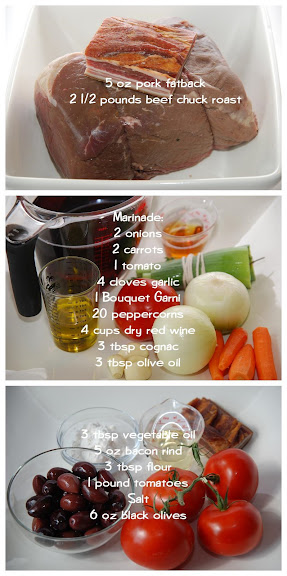
You can find the recipe for Éstouffade de Boeuf Provençale (Braised Beef Casserole, Provence Style) in the book
Le
Cordon Bleu at Home (affiliate link). To see how the rest of the Whisk Wednesdays group fared with this week's recipe, click
here (or check out the sidebar) and then click on each blogger!
 The marinade is PURPLE!Tasting Notes
The marinade is PURPLE!Tasting NotesI made some {well, many} mistakes on this seemingly, easy pot roast. Too bacon-y. Too over-cooked. Sauce was runny. But, everyone enjoyed it, even so, and it was even better the next day. {No anchovies this week! Yay} Next time, I'll try Harold McGee's tip to use a cooler oven (200˚F for the first two hours and then 250˚F for the last hour). I'll also check my butcher for fatback. And, I'll spend more time reducing the sauce. And maybe I'll ask for a
Moroccon Tagine for Christmas! That should definitely help!
Next Week (September 24)• Blanquette de Veau à l’Ancienne (White Veal Stew with Onions and Mushrooms) page 55-56
. . . . . . . . . .
Running total: $752.74 + $21.00 (beef) + $6.46 (marinade) + $4.48 (finishing) = $784.68
Butter used so far: 7 pounds, 27 tablespoons
More to Explore:
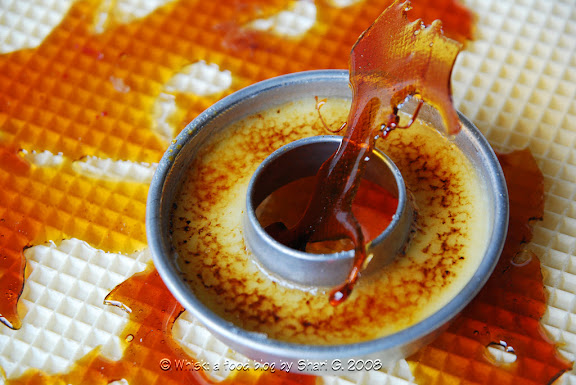 Crème Brûlée, which means "burnt cream", used to be the dessert I'd look for on menus when eating out. A favorite restaurant of ours in Ottawa is West End Station Bistro. We used to go there so often, they knew us. Once, when the babysitter called to say we had to get home right away [baby was hungry and bottle wasn't working], the restaurant let us take home two crème brûlées to broil in our oven. The next day, we brought back the empty ramekins. Now that's customer service!
Crème Brûlée, which means "burnt cream", used to be the dessert I'd look for on menus when eating out. A favorite restaurant of ours in Ottawa is West End Station Bistro. We used to go there so often, they knew us. Once, when the babysitter called to say we had to get home right away [baby was hungry and bottle wasn't working], the restaurant let us take home two crème brûlées to broil in our oven. The next day, we brought back the empty ramekins. Now that's customer service!.jpg) The recipe I usually use for crème brûlée bakes in a water bath, the oven is set to 300˚F, and the custard bakes for 25-30 minutes. This version has no water bath, the oven is set at a lower temperature (200˚F), and the custard bakes for 1 hour (or more!). So, since it was so jiggly even after extra time in the oven, I popped it into the freezer after it cooled to room temperature. It tasted refreshing this way. In fact, the ingredients for crème brûlée are the same as crème anglaise which is the base for ice cream.
The recipe I usually use for crème brûlée bakes in a water bath, the oven is set to 300˚F, and the custard bakes for 25-30 minutes. This version has no water bath, the oven is set at a lower temperature (200˚F), and the custard bakes for 1 hour (or more!). So, since it was so jiggly even after extra time in the oven, I popped it into the freezer after it cooled to room temperature. It tasted refreshing this way. In fact, the ingredients for crème brûlée are the same as crème anglaise which is the base for ice cream. You can find the recipe for Crème Brûlée in the book Baking:
From My Home to Yours (affiliate link) by Dorie Greenspan. To see how the rest of the TWD group fared with this week's recipe, click here and then click on each blogger!
You can find the recipe for Crème Brûlée in the book Baking:
From My Home to Yours (affiliate link) by Dorie Greenspan. To see how the rest of the TWD group fared with this week's recipe, click here and then click on each blogger!  Nikki from Nik Snacks gave me the "You make my day award". Well, she made my day with this one. Nikki actually went to Le Cordon Bleu school, has her own blog, teaches cooking classes, is an Editorial Assistant at a local newspaper, and runs her own catering business! Now that's busy.
Nikki from Nik Snacks gave me the "You make my day award". Well, she made my day with this one. Nikki actually went to Le Cordon Bleu school, has her own blog, teaches cooking classes, is an Editorial Assistant at a local newspaper, and runs her own catering business! Now that's busy.










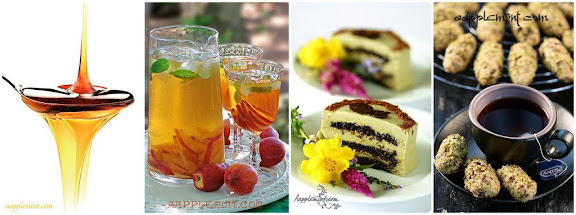


.jpg)
.jpg)
+800+low.jpg)
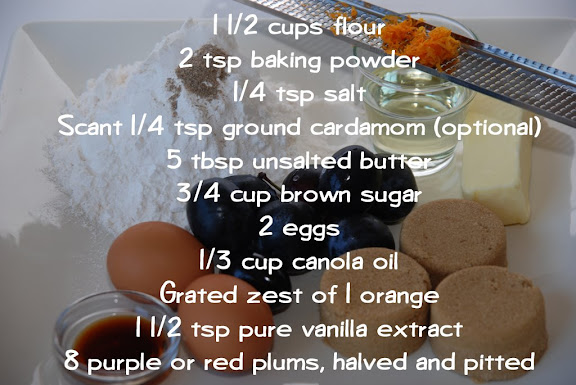
.jpg)


.jpg)



.jpg)







.jpg)











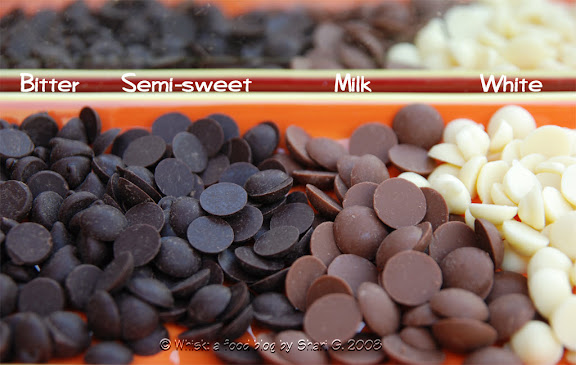

.jpg)






